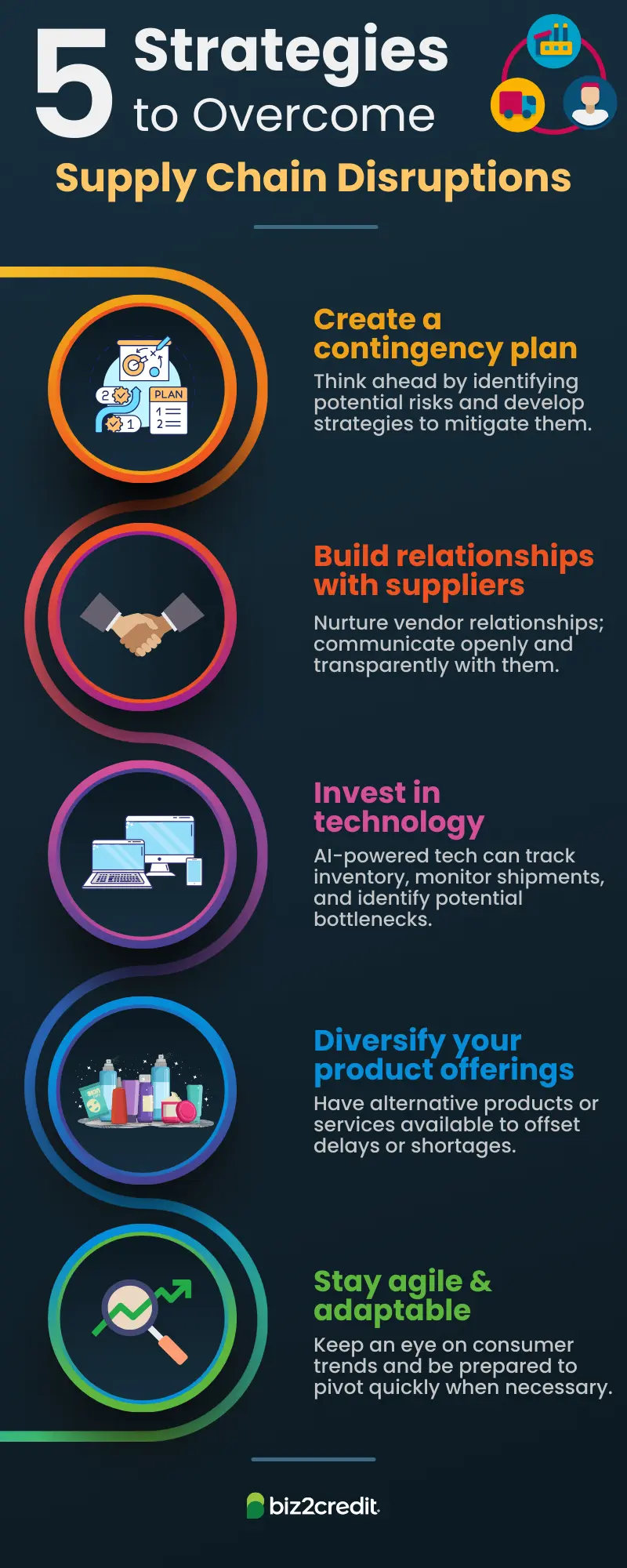Small Business Guide to Managing Supply Chain Disruptions
A
streamlined
supply
chain
is
an
operational
advantage,
the
kind
that
most
people
don’t
notice
until
a
disruption
occurs.
Then,
“business
as
usual”
becomes
a
chaotic
mess
that
can
quickly
lead
to
lost
sales,
damaged
relationships
with
customers,
and
financial
strain.
It’s
no
wonder
that
the
U.S.
Chamber
of
Commerce
reports
that
supply
chain
issues
are
one
of
the
biggest
concerns
small
businesses
face,
second
only
to
inflation.
For
small
businesses,
supply
chain
disruptions
can
range
from
something
as
small
as
a
truck
breaking
down
to
a
global
pandemic
that
closes
ports
and
shutters
manufacturing
plants.
So,
how
can
your
business
navigate
this
operational
challenge?
Read
on
for
the
strategies
you
need
to
manage
supply
chain
disruptions
in
business.
In
this
article,
we
cover:
What
Is
a
Supply
Chain?
A
supply
chain
is
the
interconnected
network
of
organizations,
activities,
resources,
information,
and
technologies
involved
in
producing
and
delivering
goods
or
services
to
customers.
It
encompasses
the
entire
process
from
sourcing
raw
materials
to
manufacturing,
distribution,
warehousing,
transportation,
and
ultimately,
reaching
the
end
consumer.
Essentially,
it’s
the
series
of
steps
and
interactions
that
transform
raw
materials
into
finished
products
and
ensure
their
timely
delivery
to
the
right
place,
at
the
right
time,
and
in
the
right
quantity.
Common
Supply
Chain
Disruptions
for
Small
Businesses
Sometimes,
supply
chains
can
spiral
out
of
control,
leaving
businesses
scrambling
to
pick
up
the
pieces.
One
moment,
you’re
operating
normally
with
everything
going
according
to
plan,
and
then
the
next,
something
happens,
and
you’re
blindsided.
Perhaps
a
key
supplier
goes
bankrupt,
leaving
you
high
and
dry
without
an
indispensable
component.
Then,
there’s
the
ever-present
risk
of
natural
disasters
like
floods,
fires,
or
hurricanes,
which
can
shut
down
production
facilities
and
disrupt
transportation
routes.
And
let’s
not
forget
about
the
unpredictable
nature
of
geopolitical
events
or
changes
in
regulations,
which
can
throw
a
wrench
into
your
carefully
laid
plans.
A
recent
example
would
be
the
ordeal
many
businesses
endured
during
the
COVID-19
period,
where
lockdowns,
border
closures,
and
supply
chain
disruptions
became
the
new
normal
overnight.
To
make
matters
worse,
sometimes
supply
chain
disruptions
happen
at
the
same
time
as
a
sudden
increase
in
demand
for
your
product.
This
happened
during
the
pandemic,
but
it
also
happens
whenever
there
is
a
major
winter
storm
or
a
hurricane
as
people
scramble
to
stock
up
on
items
like
bread
and
toilet
paper.

5
Strategies
to
Overcome
Supply
Chain
Disruptions
So,
what
strategies
can
your
small
business
employ
to
manage
supply
chain
disruptions
and
keep
operations
running
smoothly?
Here
are
a
few
tips:
1.
Create
a
contingency
plan
As
much
as
you
may
want
your
supply
chain
to
be
reliable
365
days
a
year,
things
don’t
always
work
out
that
way.
That’s
why
it’s
wise
to
have
a
contingency
plan
in
place
for
when
things
go
sideways.
To
get
working
on
a
contingency
plan,
start
by
identifying
potential
risks
and
develop
strategies
to
mitigate
them.
This
could
include
diversifying
your
supplier
base,
stockpiling
inventory,
or
establishing
alternative
transportation
routes.
By
thinking
ahead
and
having
a
plan
B
(and
maybe
even
a
plan
C),
you’ll
be
better
prepared
to
handle
whatever
curveballs
come
your
way.
2.
Build
strong
relationships
with
suppliers
Your
suppliers
are
more
than
just
vendors;
they’re
partners
in
your
business.
Nurture
these
relationships
and
communicate
openly
and
transparently
with
them.
When
building
trust
and
loyalty,
you’ll
be
in
a
better
position
to
weather
supply
chain
disruptions
together.
Plus,
you’ll
have
a
better
understanding
of
each
other’s
capabilities
and
limitations,
making
it
easier
to
collaborate
on
solutions
when
problems
arise.
3.
Invest
in
technology
If
you’re
running
a
blue
collar
business,
you
might
be
used
to
running
things
“the
old
fashioned
way.”
But
modern
AI-powered
technology
is
revolutionizing
every
aspect
of
business,
including
the
supply
chain.
And
some
time
and
money
invested
today
will
return
with
interest
down
the
road.
For
instance,
if
you
invest
in
software
and
systems
that
provide
real-time
visibility
into
your
supply
chain,
you
can
easily
track
inventory
levels,
monitor
shipments,
and
identify
potential
bottlenecks
before
they
become
problems.
4.
Diversify
your
product
offerings
One
way
to
mitigate
the
impact
of
supply
chain
disruptions
is
to
diversify
your
product
offerings.
If
one
product
is
experiencing
delays
or
shortages,
having
alternative
products
to
fall
back
on
can
help
offset
any
losses.
This
could
involve
expanding
your
product
line,
offering
complementary
products
or
services,
or
exploring
new
markets
and
customer
segments.
5.
Stay
agile
and
adaptable
Today’s
businesses
win
by
being
flexible.
If
you’re
going
to
grow
and
manage
unexpected
outcomes
effectively,
then
you
need
to
be
ready
to
change
your
plans
at
the
drop
of
a
hat.
Stay
agile
by
continuously
monitoring
market
trends,
customer
preferences,
and
supply
chain
dynamics.
Also,
be
prepared
to
pivot
quickly
when
necessary.
This
might
mean
adjusting
production
schedules,
renegotiating
contracts,
or
finding
creative
solutions
to
unexpected
challenges.
Manage
Supply
Chain
Disruptions
Effectively
Supply
chain
disruptions
are
an
unfortunate
part
of
doing
business,
and
they
can
be
especially
painful
for
small
companies.
But
like
anything
else,
you
can
minimize
the
impact
of
these
disruptions
and
keep
your
business
running
and
your
customers
happy
by
proactively
implementing
the
strategies
mentioned
above.
And
if
you
need
resources
or
financing
to
get
you
through
a
supply
chain
disruption,
be
sure
to
browse
the
options
available
on
our
website.
Comments are closed.